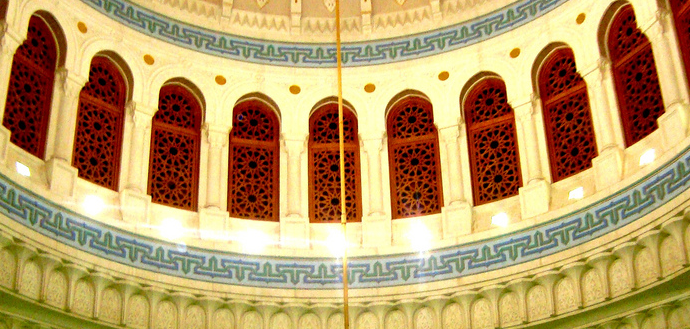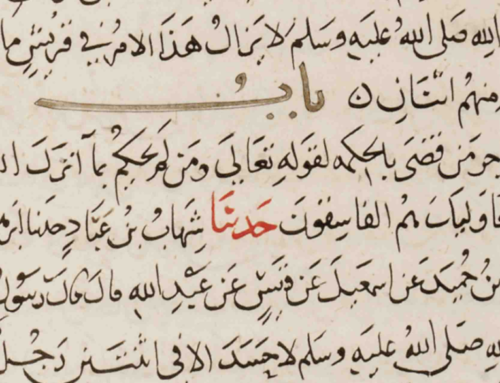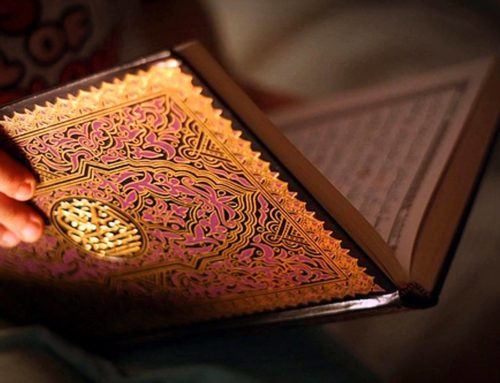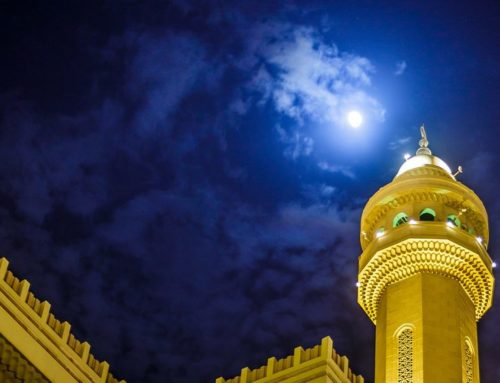Translated by Ismaeel Nakhuda
An Excerpt from Shari’ah wa Tariqah ka Talazum [1]This translation was done using the original Urdu version of Shaykh al-Hadith’s Shari’ah wa Tariqah ka Talazum and an Arabic translation of the Urdu, Talazum al-Shariah wa … Continue reading
It is also called the exercise (shughal) of Rabitah, Barzakh and Wasta (see Ta’lim al-Din); to the mashayikh of Tasawwuf it is a very important exercise. The mashayikh have written many benefits of this. Some seniors said it is unconditionally (mutlaqan) impermissible. According to this slave, this is incorrect, as Tasawwur al-Shaykh is understood from many hadiths. Because of this, I have not understood why some have deemed it unconditionally impermissible.
Sayyidatuna ‘Aishah (may Allah be pleased with her) says regarding the person in ihram wearing scent: “It is as if I am now looking at the shine of the hair perfume in the hair parting of the Prophet of Allah (may Allah bless him and grant him peace)…”
It is also mentioned in the hadith of Sayyiduna ‘Abd Allah Ibn Mas’ud (may Allah be pleased with him), as mentioned in Al-Takashshuf (p.670) quoting Al-Bukhari and Muslim: “It is as if I am seeing the Messenger of Allah (may Allah bless him and grant him peace) telling the story of a messenger from among the messengers whose nation hit him…”
There is also the hadith of Sayyiduna ‘Ali (may Allah be pleased with him) in Sunan Abu Dawud, in the Chapter Regarding Rings of Iron, that Allah’s Messenger (may Allah bless him and grant him peace) said to him: “Say, ‘O Allah, guide me and make me adhere to the straight path,’ and when you mention ‘guide’ (hidayah), keep in mind the right path, and when you mention the straight (path), keep in mind the straightness of the arrow.'”
My master and murshid, Mawlana Khalil Ahmad Saharanpuri, writes in the commentary of this in Badhl al-Majhud that: “In other words, when mentioning ‘guide’ keep in your heart the right path. In the same way that a path is tread in its middle and the person walking does not turn right or left, and if he were to turn then he would not reach the goal, then, likewise, when mentioning ‘guide’ keep in mind that reaching the purpose is dependent on remaining firm on the path. Similarly, keep in mind the straightness of an arrow when mentioning ‘adhere to the straight path’, in other words its straightness and firmness in that. So, likewise, may Allah Most High keep me on the correct path and straighten me so there remains no crookedness in the way there is none in the arrow.”
Mawlana Muhammad Yahya Kandhalwi writes that Mawlana Rashid Ahmad Gangohi said in his lecture (taqrir) on Sunan Abu Dawud that: “And keep in mind the straight path when mentioning ‘guide’. He only ordered that one keeps in mind this envisioning so that one’s thoughts may not become dispersed. In addition, it is easier to contemplate those things that are perceptible through the senses (mahsusat) than those that use one’s comprehensive faculty (ma’qulat). The Prophet (may Allah bless him and grant him peace) said one should, while supplicating, envision the straightness of the path and the arrow so stray thoughts do not come to mind. In this is an indication for the permissibility of Tasawwur al-Shaykh because the rank of the shaykh is no less in front of Allah than the arrow and the path. There is also no issue if, during the envisioning, the love of the shaykh enters one’s heart. Yes, however, it would be harmful if during the envisioning one considers the shaykh to have the power of disposal (mutasarrif) in esoteric issues (batin) or believes that the shaykh is present (hadir) or that the shaykh understands his situation. It is on account of this that there is a difference of view among the mashayikh regarding Tasawwur al-Shaykh; and this dispute is one of words (lafzi). Those who say it is permissible intend the first and those who forbid it intend the second. However, when the ‘ulama of the latter era saw that this is leading to the general masses’ corruption of belief (‘aqidah) then they unconditionally forbade it, and this is correct according to the situation.”
There are many narrations in the books of hadith regarding this issue. There is a hadith in Hayat al-Sahabah in the Chapter Regarding the Reality of Faith from Sayyiduna Anas Ibn Malik (may Allah be pleased with him), who narrates: “The Prophet of Allah (may Allah bless him and grant him peace) said: ‘What state did you awake in the morning O Harith Ibn Malik?’ He said: ‘I woke, O Prophet of Allah, as a true believer.’ The Prophet of Allah (may Allah bless him and grant him peace) said: ‘Certainly, every truth has a reality, so what is the reality of what you say?’ He replied: ‘I have turned away from the world; I have made thirsty my days and awoken my nights. It is as if I see the throne of my Cherisher and it is as if I see the people of paradise meeting each other in it and the people of the screaming.’ So the Prophet of Allah (may Allah bless him and grant him peace) said to him: ‘You are a man whose heart Allah has enlightened. You have known the truth, so remain firm on it.'” (Ibn ‘Asakir has produced this hadith, and Al-‘Askari has mentioned it in Jamharat al-Amthal and so has Ibn al-Mubarak in Kitab al-Zuhd)
Abu Nu’aym, in his book Hilyat al-Awliya (vol.1 p.242), has included a hadith narrated by Sayyiduna Anas Ibn Malik (may Allah be pleased with him) that: “Sayyiduna Mu’adh Ibn Jabal (may Allah be pleased with him) entered upon the Prophet of Allah (may Allah bless him and grant him peace) who said: ‘What state did you awake in the morning, O Mu’adh?’ He replied: ‘I woke as a believer in Allah Most High.’ So the Prophet of Allah (may Allah bless him and grant him peace) said: ‘Certainly, every word should be substantiated and for every truth there is a reality. What is the confirmation of what you say?’ He said: ‘O Prophet of Allah I have never woken in the morning except that have I felt that I shall not live till the evening. I have never spent an evening except I have felt that I shall not live till the morning. I have never taken a step except I have felt I shall not follow it with another. It is as if I am seeing every Ummah on its knees being called to its book, with it is its prophet and its idols that it worshipped apart from Allah. It is as if I am looking at the punishment of the people of fire and the rewards of the people of paradise.’ The Prophet of Allah (may Allah bless him and grant him peace) said: ‘You have known the truth, so remain firm on it.'”
Imam al-Tirmidhi narrates a hadith in his Al-Shamail from Sayyiduna ‘Awn Ibn Abu Juhayfah who is narrating from his father who said: “I saw the Prophet (may Allah bless him and grant him peace) and on him was a red garb and it is as if I am seeing the lustre of his shins.” Abu Juhayfah Sufyan (may Allah be pleased with him) said: “According to my understanding the clothing was printed red.” (Al-Haythami said its narrators are reliable (thiqah); it is mentioned likewise in Al-Bajuri’s commentary of Al-Shamail).
Likewise, there is the narration of Sayyiduna Anas (may Allah be pleased with him) who said that when the Messenger of Allah (may Allah bless him and grant him peace) intended to write to the non-Arabs (‘ajam), it was said to him: “Indeed, the ‘ajam only accept letters that are sealed. He had a ring made. It is as if I can see its shine in his palm.” (Al-Tirmidhi has mentioned this hadith in his Al-Shamail)
Likewise, there are hundreds of narrations regarding [the concept of] envisioning (tasawwur) in the books of hadith. On account of this it is difficult to consider Tasawwur al-Shaykh to be unconditionally impermissible. However, if it leads one to something that is not permitted in Shari’ah then it would be considered impermissible. Otherwise, for removing thoughts (khawatir), or for those who are afflicted with metaphorical love (al-‘ishq al-majazi), it is an effective elixir.
Hakim al-Ummah Mawlana Ashraf ‘Ali Thanawi writes in Ta’lim al-Din (page 177): “It is mentioned in the books of [this] science that the plentiful envisioning of the image of the shaykh and his perfect traits gives birth to his love and strengthens the spiritual connection (nisbah); it is through a strong nisbah that many types of blessings (barakah) can be gained. Some researchers (muhaqqiqs) say that the only benefit of Tasawwur al-Shaykh is that one thought removes another, something that allows one to focus and removes thoughts (khawatir).
“Anyway, whatever its benefit and wisdom, it is the writer’s (Hakim al-Ummah’s) experience that this exercise is of benefit to the elite and extremely harmful for the general masses in that at times it takes them to the level of worshipping images. It is on account of this that Imam al-Ghazali and other researchers forbade instructing the general masses and the ignorant from undertaking such exercises that cause kashf etc. It is on account of this that the general masses should be kept away from this exercise and if the elite do it then this should be done with caution — they should not assume that the shaykh is omnipresent (hadir wa nazir) or their aide and helper, as a ‘similitudinary form’ (al-surah al-mithaliyyah) can at times present itself in front of a person through the abundance of Tasawwur al-Shaykh. At times it is only a thought and at times it is a latifah ghaybiyyah that has taken this form and the shaykh does not even know of it most of the time. It is at this point that ignorant people mostly fall into error.”
Shaykh al-Islam Mawlana Hussayn Ahmad Madani (may Allah enlighten his grave) writes in his Maktubat (page 34, volume 1 — number 11): “Tasawwur al-Shaykh protects one from devilish insinuations (waswasah) and confusing thoughts. Tasawwur al-Shaykh also causes amazing and strange states. The shaykh has no knowledge of this, nor does he intend to teach the murid or benefit him, nor is he attentive to the murid, rather these are natural effects that Allah Most High has made a means for safety from devilish insinuations and to descend divine blessings. However, due to the general masses falling in err in this path, the learned of this Ummah have exercised caution in it. Otherwise, it is permissible in terms of Shari’ah and its proof are in the hadiths.” [2]I would like to thank my friend Abu Salih for providing me with the translation of Shaykh al-Islam Mawlana Hussayn Ahmad Madani’s quotes throughout this piece (translator).
In another letter (page 160, volume 1, number 451), Shaykh al-Islam writes: “Even though Shah Isma’il Shahid forbade the exercise of Barzakh as a preventive measure (saddan li ‘l-zari’ah). It has, however, reached me that Shah ‘Abd al-Ghani Mujaddidi would not forbid it. Some people asked him regarding its permissibility, so, to prove its permissibility, he presented them the wording from the hadith of Imam Hasan (may Allah be pleased with him) in which he mentions asking his maternal uncle, Hind Ibn Abu Halah, the description of the Messenger of Allah (may Allah bless him and grant him peace) and, in the question, mentions the wording ‘at’allaqu bihi’, from which it becomes clear that the purpose was to memorise his (may Allah bless him and grant him peace) personage and appearance — this is the exercise of Barzakh.”
This hadith is mentioned in much detail in Shamail al-Tirmidhi, which this sinner has translated into Urdu under the name Khasail al-Nabawi. [3]This was subsequently translated into English. In its commentary I have written: “I desired that he mentions some of those beautiful features to me so that I can make his description a proof and testimony for myself, and memorise those beautiful features, and, if possible, try to emulate them.”
Shaykh al-Islam writes in another letter (page 83, volume 4): “To establish and bring a figure in the mind is linguistically called ‘tasawwur‘, this is regardless of whether it is of an animate or inanimate object, or of a famous or ordinary person, or of a saint and wali, or one’s shaykh, father or mother, and regardless of whether there is hope of gaining some benefit or not. However, Tasawwur al-Shaykh is the name commonly given to [the concept] of bringing and establishing the figure of a pious saint in one’s mind, especially the personality and face of one’s murshid.
“To establish and bring the picture of one’s murshid is, by consensus, intrinsically permissible, but also beneficial and recommended by the noble Companions and the Prophet of Allah (may Allah bless him and grant him peace). Sayyiduna Hasan (may Allah be pleased with him) established the picture and figure of the Messenger of Allah (may Allah bless him and grant him peace) after repeatedly asking his maternal uncle Hind Ibn Abu Hala (may Allah be pleased with him). The Messenger of Allah (may Allah bless him and grant him peace) has mentioned the appearance, figure, clothes etc. of Sayyiduna Ibrahim, Sayyduna Musa and Sayyiduna ‘Isa (peace be upon them) to the Companions, something that clearly shows that the purpose was to allow those listening to imagine in their minds the figure and appearance of those senior personalities.”
After this, Shaykh al-Islam mentions numerous hadiths in which the messenger of Allah described the appearance of the prophets and their features etc. Hence, the Prophet (may Alah bless him and grant him peace) mentions regarding Sayyiduna Musa (peace be upon him) that Muhammad Ibn al-Muthanna narrates from Ibn Abu ‘Adi from Dawud from Abu ‘l-‘Aliyah from Ibn ‘Abbas (may Allah be pleased with him) who said: “We travelled with the Messenger of Allah between Makkah and Madinah and we passed by a wadi. So, he asked which wadi is this. So they said it is the Wadi ‘l-Azraq. He said, ‘It is as if I am looking at Musa.'” He then mentioned something about his complexion and hair, which Dawud could not remember. “He had placed his fingers in his ears and he had raised his voice calling to Allah, seeking his aid while he passed this wadi.” (Muslim)
The Prophet of Allah (may Allah bless him and grant him peace) said: “I saw Musa (peace be upon him), he had a thin body. He resembled the men of Shanuah. I saw ‘Isa Ibn Maryam (peace be upon him). From among all those whom I have seen, the closest he resembled is ‘Urwah Ibn Mas’ud. I saw Ibrahim (peace be upon him). From among all those whom I have seen closest in appearance is your companion (in other words himself)…” (Muslim)
After narrating several hadiths, Shaykh al-Islam then writes: “These types of narrations are mentioned in abundance in the books of sahih hadiths, which not only establish the permissibility of Tasawwur al-Shaykh, rather its recommendation [as a practice] and preference also becomes evident from them. It also becomes clear from these hadiths that some sort of spiritual blessing (fayd) and benefit is produced from it otherwise the Prophet (may Allah bless him and grant him peace) would not do it; rather he would have forbidden it. It is because of these benefits and reasons that in previous times the people of insight from among the god fearing and pious did Tasawwur al-Shaykh and made plans to benefit from it. Qutb al-‘Alam Haji Imdad Allah Muhajir Makki (may Allah sanctify his secret) wrote [4]The original letter is in Persian. to his special khalifah Mawlana Muhammad Qasim Nanawtwi: ‘If you have time, then sit alone after the Fajr or Maghrib or ‘Isha prayer in a room or its like and, having emptied your heart from all thoughts, turn towards here and envision you are sitting in front of your shaykh and that the divine fayd is coming from the shaykh’s heart to your heart. If the heart feels good, and there is a desire and longing then good, or else preoccupy yourself in the dhikr of al-Nafi wa ‘l-Ithbat [5]For further information on the Al-Nafi wa ‘l-Ithbat visit. (the dhikr of Affirmation and Negation) with medium audibility. Stay like this for, in the least or at the most, one or two hours.’
“In addition, Haji Imdad Allah writes in another letter: ‘If you have time after the Fajr or Maghrib prayer then for a short while remain in meditation (muraqabah) and envision you are sitting in front of your murshid and that something is coming from the murshid’s heart to your heart. Insha Allah there will be tawajjuh from this side (from Haji Imdad Allah) to you also. If the grace of Allah is connected by circumstances then there will be benefit. Be rest assured.’
“Imam Shah Wali Allah writes in Al-Qawl al-Jamil: ‘They (the Chishti mashayikh) say that the greatest pillar is attaching the heart to the shaykh with love and reverence, and keeping in mind his image.’ I (Shah Wali Allah) say: indeed, Allah Most High displays himself in many different places/manner, to such an extent that every worshipper — regardless of whether he is intelligent or not — will find Allah Most High in front of him being worshipped, in accordance to his status. It is on account of this secret that facing the Qiblah and the setting (istiwa) over the ‘arsh have been revealed in the Shari’ah; the Prophet of Allah (may Allah bless him and grant him peace) said: ‘When one of you offers prayer, then do not spit to the front, for indeed Allah Most High is between him and his Qiblah’ … So, O salik, there is no harm in you only turning to Allah and only attaching your heart to Him, even if this is by means of focusing towards the ‘arsh, and focusing on that light (nur) which the Most High has placed on the ‘arsh and it is of a deeply bright colour like the colour of the moon; or by turning towards the Qiblah, as the Prophet of Allah (may Allah bless him and grant him peace) has indicated towards this; so this is like the meditation (muraqabah) of this hadith. Allah knows most.”
Then, after a lengthy discussion, Shaykh al-Islam (may Allah enlighten his grave) writes: “This method of Tasawwur al-Shaykh has come from the noble predecessors with powerful and beneficial results. However, the people of the latter times exceeded the limits and exaggerated in this matter and chose to include in it such things which are harmful and drives [them] away from the straight path (al-sirat al-mustaqim).”
Then, after quoting three or four fatwas from Al-Fatawa al-Rashidiyah and some of Mawlana Nanawtwi’s letters, Shaykh al-Islam writes: “In sum, removing khawatir, developing concentration and becoming determined in worship are qualities stressed to a level that requires no elaboration. Since the effects of Tasawwur al-Shaykh in this are extremely beneficial, experience and religious texts have encouraged the elders of this Ummah to perform it. The Ummah has gained innumerable benefits from this. However, since later wrongdoers mixed it with forbidden and impermissible practices — such as believing that the shaykh is omnipresent (hadir wa nadhir); or becoming so absorbed in visualising the shaykh that one feels dispensable of and becomes neglectful of the real purpose and the real beloved; or, similar to the Ka’bah during prayers, making the shaykh the Qiblah and turning towards him; or believing that the shaykh is able to dispose (mutasarrif) inside the murid; or excessively exalting the image or the shaykh; or for those who do not fear the consequences or stupid people to, on account of it, begin worshipping these images as has become common among many of the pirs of bid’ah — it has become necessary on the wise among the senior mashayikh that they dwell on this issue and banish the means of shirk and kufr from the roots. Anyway, this issue (Tasawwur al-Shaykh) is not impermissible or necessary in absolute terms. One should contemplate and exercise in-depth thought when issuing fatwas and acting on it. And Allah knows best. The disgrace to his predecessors — Husayn Ahmad (may Allah forgive him), 28 November 1957.”
It is mentioned in Arwah-e-Thalatha under the particulars of Sayyid Ahmad Rai-Barelwi (may Allah enlighten his grave) that when he was in the service of his shaykh, Shah ‘Abd al-‘Aziz Dehlawi, he taught him the exercise of Rabitah. Sayyid Ahmad excused himself at which Shah ‘Abd al-‘Aziz recited a Persian poem the literal meaning of which is: If the kamil shaykh orders his murid to perform prayer on a mat immersed in wine then he should fulfil his order, for the salik is ignorant of the particularities of the tariq and its secrets that lead to the purpose.
At this, Sayyid Ahmad replied: “Order me to do any disobedience and I shall oblige. This is not an act of disobedience; it is polytheism. It is not agreeable.” When Shah ‘Abd al-‘Aziz heard this he embraced him and said: “Well then, we shall take you along the path of nubuwwah. You are not suited to the path of wilayah.” [6]Explaining these two terms, Shaykh Mufti Kamaluddin Ahmed, khalifah of Peer Zulfiqar Ahmad, wrote the following in an email to the translator: “Basically, Mujaddid Alf al-Thani Imam Rabbani … Continue reading
I have mentioned a story regarding this poem in my autobiography, Aap Biti, which I heard from my elders. The translation of the poem is: Drench the prayer mat in wine when the perfect (kamil) murshid orders such, for indeed the salik is ignorant of the stations of the Path.
The story that I heard is that one of the students of Shah ‘Abd al-‘Aziz Dehlawi asked him the meaning of this poem, so the shaykh said: “Remain occupied in studying and imparting knowledge. What concern do you have with such things?” However, when the student insisted, Shah ‘Abd al-‘Aziz handed him ten rupees and told him to go to such and such an inn and ask the keeper if there are any women available. The student first of all became absorbed in thought. However, as he had asked himself regarding the poem and insisted on understanding its meaning, he went to the place. On reaching there and asking, the keeper said: “A beautiful girl has just arrived and she is in that room. I will go and speak to her and return to you.” The keeper went and spoke to the woman. He then told the student to return at night. When he arrived there at night, the woman was seated head lowered and crying. The student became extremely surprised and told her that he had not forced her or pressured her. The woman, however, began to sob more and the student was left in a conundrum. After one hour, she said: “I am oppressed and repressed. I have been without food for so many days. I have been wandering for so many days. My husband left me and there is no news of where he is. I have been looking for him for two to three months.” The student then asked the woman her husband’s name and where he is from. When she informed him, it became clear that the lost husband was the student himself. He then asked her to reveal her face and look up. On doing so they both recognised each other — the husband had left home in want of knowledge. He then remained with the woman that night in that place. In the morning he came to the service of Shah ‘Abd al-‘Aziz and said that the poem was completely true.
I have heard many of these types of stories from my elders. However, the first condition is that the shaykh is a kamil, one who epitomises (jam’i) both Shari’ah and Tariqah, is knowledgeable of the signs of the divine secrets, and annihilated in the obedience of Allah and His messenger — this is not the situation of all who claim saintliness (buzurgi).
Once, Mawlana Rashid Ahmad Gangohi was in a passionate mood and the issue of Tasawwur al-Shaykh was being discussed. He said: “Shall I say?” In response it was said: “Yes, say.” He said: “Shall I say?” In response it was said: “Yes, say.” He said: “Shall I say?” It was said: “Say.” He said: “For three complete years, the face of Haji Imdad Allah remained in my heart and I did not do anything without asking him.” Then he became more passionate and said: “Shall I say?” In response it was said: “Yes, surely.” He said: “For so many years (the person reporting the story does not remember the exact amount) the Prophet (may Allah bless him and grant him peace) was in my heart and I did not do anything in that time without asking him (may Allah bless him and grant him peace).” Having said this, he became even more passionate and said: “Shall I say more?” It was replied: “Yes, say.” He, however, remained silent. People insisted, so he said: “Stop, let it be.” The next day, after much pleading, he said: “After that was the status of ihsan.”
Hakim al-Ummah Mawlana Ashraf ‘Ali Thanwi comments on this story: “To repeat the question ‘shall I say’ is to ascertain the eagerness and aptitude of those listening because not everyone is capable of bearing such secrets … and not repeating the question the second time maybe because now there is no need. The reason for questioning once is because gaining something after seeking it is more heart penetrating. In respect to the presence of the image and taking advice from it — this is at times because of the strength of one’s imagining, and at times something that is out of the extraordinary (kharq li al-‘adah) in that the soul takes the form of a physical body. It is clear that in both instances there is no possibility of believing that the image is necessarily and with continuance omnipresent (hadir or nazir), or any possibility of isti’anah and istighatha. Then, in relation to the status he said: “Stop, let it be.” With regard to the next stage, he said: “Stop, let it be,” then upon their insistence the next day, he mentioned it to be the rank of ihsan — if this is the explanation of the silence of the day before, then not telling on that day was due to the wisdom (hikmah) that according to the exotericists (ahl al-zahir) this (i.e. ihsan) is no greater than the first two stages; in that they have no worth for it. To say it after the insistence is to instruct that this is the greatest stage of them all, as this is the purpose and the maqam. Those [other] stages are not the purpose and are hal (states) — Shattan ma baynahum (How different they are). And if this is not its explanation, then he has not disclosed it. This may be because the intellect of the masses is unable to bear it, or maybe it is a divine revelation (tajalliyah) from the many revelations, and disclosure of that state would lead to academic objections, because the exotericists (ahl al-zahir) are often led to raise objections regarding the secrets of the Sufis.” (Aap Biti, 6, 475).
| ↑1 | This translation was done using the original Urdu version of Shaykh al-Hadith’s Shari’ah wa Tariqah ka Talazum and an Arabic translation of the Urdu, Talazum al-Shariah wa ‘l-Tariqah, by Shaykh ‘Abd al-Hafiz Makki, one of the senior khalifahs of the author. The Arabic version also includes references of hadiths, which have been produced in the translation above. The Arabic version of the book has seen two publications; the first publication can be accessed here (translator). |
|---|---|
| ↑2 | I would like to thank my friend Abu Salih for providing me with the translation of Shaykh al-Islam Mawlana Hussayn Ahmad Madani’s quotes throughout this piece (translator). |
| ↑3 | This was subsequently translated into English. |
| ↑4 | The original letter is in Persian. |
| ↑5 | For further information on the Al-Nafi wa ‘l-Ithbat visit. |
| ↑6 | Explaining these two terms, Shaykh Mufti Kamaluddin Ahmed, khalifah of Peer Zulfiqar Ahmad, wrote the following in an email to the translator: “Basically, Mujaddid Alf al-Thani Imam Rabbani Shaykh Ahmad Sarhindi (may Allah mercy him) coined these two terms in his Maktubat. I am not aware of prior usage of them, but certainly Imam Rabbani (may Allah mercy him) elaborates on these concepts in his Maktubaat. The path of wilaya is the path of abundant mujahadah and also leads one to first experience fana-e-wujudi and then fana-e-shuhudi. This is the path that Imam Rabbani (may Allah mercy him) states that he himself follows. He later writes that Allah Most High inspired him with another path, the path of nubuwwah, that bypasses fana-e-wujudi and tawhid-e-wujudi, and he feels this is the preferred path.” |







Jazakumullahu Khairan!
One question… if the path of Wilaya is by Mujahadah, then the path of Nubuwwah is by what? I have not fully understood that statement of Shah Abd al-`Aziz (ra) even after reading the footnote.
Jazakumullahu Khairan in advance.
ne question… if the path of Wilaya is by Mujahadah, then the path of Nubuwwah is by what? I have not fully understood that statement of Shah Abd al-`Aziz (ra) even after reading the footnote.
Jazakumullahu Khairan in advance.
Reply
As-salamu ‘alaykum,
Jazak’Allah khayran.
Interestingly, Mawlana Sayyid Muhammad ‘Ali Mongeri (may Allah shower His mercy upon him) relates that his Shaykh Mawlana Fadl-e-Rahman Ganj Muradabadi (may Allah shower His mercy upon him) would not teach his disciples the exercise of Tasawwur-e-Shaykh despite repeated requests. Mawlana Ganj Muradabadi (may Allah shower His mercy upon him) also related that his own Shaykh did not do so either.
As-salamu ‘alaykum,
Brother ‘as-Salik’, if you’re able to read Urdu, please refer to Sirat-e-Sayyid Ahmad Shahid (Volume 6 of Tarikh-e-Da’wat wa ‘Azimat), p. 122-123. Mawlana Sayyid Abu ‘l-Hasan ‘Ali Nadwi has reproduced Shah ‘Abd al-‘Aziz’s own explanation of what he meant. The Shah also stated that this should be considered the greatest rank of wilayah.
It is also related that he embraceed Sayyid Ahmad Shahid and kissed his forehead repeatedly.
As-salamu ‘alaykum,
The 21st vision in Imam al-Hind Shah Wali Allah Dehlawi’s Fuyud al-Haramayn, concerning the superiority of Shaykhayn Sayyiduna Abu Bakr and Sayyiduna ‘Umar over Sayyiduna ‘Ali (may Allah be pleased with them) is also interesting, and may relate to brother as-Salik’s query.
Assalamu’alaykum wa Rahmatullahi wa Barakatuhu
Shaykh Ali “Data Ganj Bakhsh” Hujwiri, the author of Kashf al-Mahjub, one of the earliest works authored on the subject of tasawwuf compares and contrasts the way of mujahadah, which is epitomized by Sayyiduna `Umar, may Allah be pleased with him, with the way of mushahadah, which is epitomized by Sayyiduna Abu Bakr, may Allah be pleased with him. Perhaps that may help Bhai Salik in finding the terminology he is looking for…
Humza
asSalaamu Alaikum,
Hafiz Abu Unaysah, Jazakallahu khair.
But unfortunately, I do not know how to read Urdu 🙁
Assalam o ‘alaykum,
I was reading “A Study of Religious Reform Movement of Sayyid Ahmad of Rai’ Bareli” and in there I came across discussion on ‘Rah-i-Nabuwwat’ and ‘Rah-i-Wilayat’. The author, Muhammad Hidayatullah, says in there,
“Proceeding further, Shah Isma’il Shahid discusses [in the beginning of Sirat-i-Mustaqim] the states (ahwal), stages (maqamat) and results (nata’ij and thamarat) of Hubb-i-Imani. Here he clearly distinguishes between the mystical type of religious life – Hubb-i-‘Ishqi, the ‘Loving Love’ (Love for the sake of Love) – and the prophetic type in which Hubb-i-Imani, the ‘Faith Love’ (Love on account of the faith) is the axis.
As he proceeds in his discussion of Hubb-i-Imani and Hubb-i-‘Ishqi, Shah Isma’il says that because Hubb-i-Imani and its ‘states’, ‘stages’, and ‘results’ and ‘fruits’ eventuate in Nabuwwat, this tariq (way) is called Rah-i-Nabuwwat (the way of the Prophethood); and because Hubb-i-‘Ishqi and its ‘states’, ‘stages’, and ‘results’ and ‘fruits’ eventuate in ma’rifat, which is khulasah (substance) of Wilayat (sainthood), this tariq is called Rah-i-Wilayat (the way of the Sainthood).
In the exposition of Hubb-i-Imani, Shah Isma’il draws our attention to some points which are quite significant for our study. He says that one of the excellent supports of Hubb-i-Imani is the adoption of a strong determination to obey the Shari’ah and an earnest eagerness to conform to the Sunnah and to avoid innovations completely. In another place Shah Isma’il says that the revival of the Sunnah was another great support of Hubb-i-Imani. …
In the third chapter Sayyid Ahmad concerns himself in explaining the modes of contemplation (tariq-i-suluk) for attaining the perfection of the ‘way of the Sainthood’ (Rah-i-Wilayat), with reference to the peculiarities and disciplines (ashghal, adhkar, muraqabat, ma’rifat, kashf, lata’if, etc.) of each of the four important Sufi orders prevalent in India at that time, namely, Qadiriyyah, Chishtiyyah, Naqshbandiyyah and Mujaddadiyyah. …
Again, in the forth chapter Sayyid Ahmad describes the processes of acquiring the excellences of the ‘way of the Prophethood’ (Rah-i-Nabuwwat), such as repentance (tawbah), silent devotion (maraqabah) and remberence of faith (dhikr-i-imani).”
I am hanafi and love deoband ulamas.Some things in this sect are similar to brailwis.The hadiths which are quoted for proof of tassawwar ul sheikh do not prove it.It is like when you tell some one your past story and scene from that story comes in to your mind and you say that like it is happening in front of you again.I live in KSA and here sufis are disliked because it leads to shirk.Yes about ALLAH,you can say like that because HE watches you all the times.